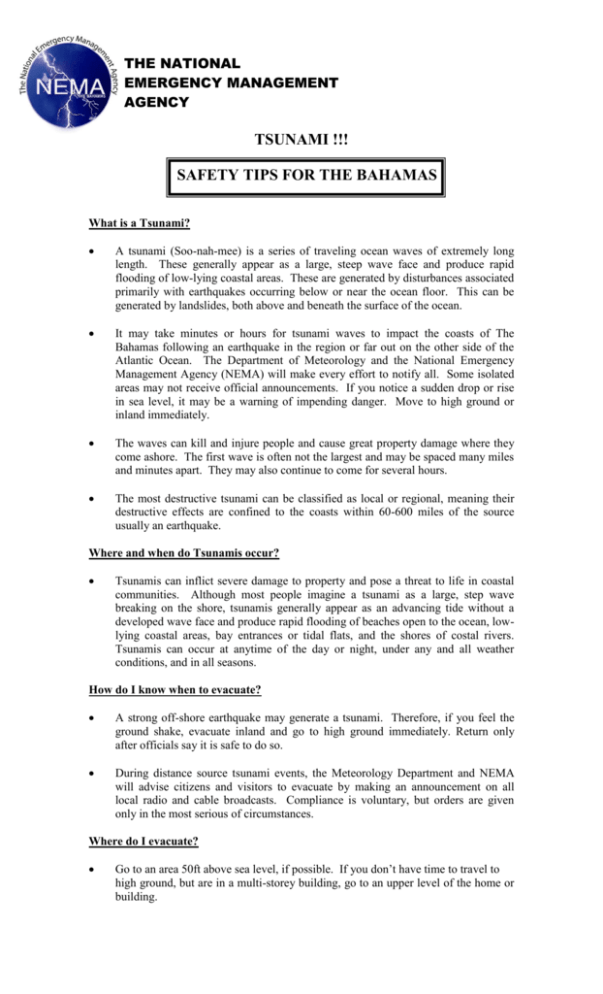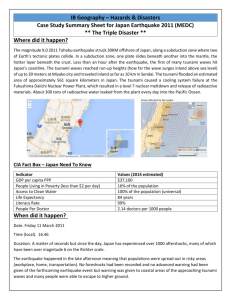TSUNAMI !!! SAFETY TIPS FOR THE BAHAMAS
advertisement

THE NATIONAL EMERGENCY MANAGEMENT AGENCY TSUNAMI !!! SAFETY TIPS FOR THE BAHAMAS What is a Tsunami? A tsunami (Soo-nah-mee) is a series of traveling ocean waves of extremely long length. These generally appear as a large, steep wave face and produce rapid flooding of low-lying coastal areas. These are generated by disturbances associated primarily with earthquakes occurring below or near the ocean floor. This can be generated by landslides, both above and beneath the surface of the ocean. It may take minutes or hours for tsunami waves to impact the coasts of The Bahamas following an earthquake in the region or far out on the other side of the Atlantic Ocean. The Department of Meteorology and the National Emergency Management Agency (NEMA) will make every effort to notify all. Some isolated areas may not receive official announcements. If you notice a sudden drop or rise in sea level, it may be a warning of impending danger. Move to high ground or inland immediately. The waves can kill and injure people and cause great property damage where they come ashore. The first wave is often not the largest and may be spaced many miles and minutes apart. They may also continue to come for several hours. The most destructive tsunami can be classified as local or regional, meaning their destructive effects are confined to the coasts within 60-600 miles of the source usually an earthquake. Where and when do Tsunamis occur? Tsunamis can inflict severe damage to property and pose a threat to life in coastal communities. Although most people imagine a tsunami as a large, step wave breaking on the shore, tsunamis generally appear as an advancing tide without a developed wave face and produce rapid flooding of beaches open to the ocean, lowlying coastal areas, bay entrances or tidal flats, and the shores of costal rivers. Tsunamis can occur at anytime of the day or night, under any and all weather conditions, and in all seasons. How do I know when to evacuate? A strong off-shore earthquake may generate a tsunami. Therefore, if you feel the ground shake, evacuate inland and go to high ground immediately. Return only after officials say it is safe to do so. During distance source tsunami events, the Meteorology Department and NEMA will advise citizens and visitors to evacuate by making an announcement on all local radio and cable broadcasts. Compliance is voluntary, but orders are given only in the most serious of circumstances. Where do I evacuate? Go to an area 50ft above sea level, if possible. If you don’t have time to travel to high ground, but are in a multi-storey building, go to an upper level of the home or building. If you are on the beach and unable to get to high ground, go inland as far as you can. Take your disaster supply kit with you, if possible. Shelters will be open as needed. Listen to your radio for details. Pets are not allowed at emergency shelters so please plan ahead for their safety. How do I get inland or to high ground? Go on foot if necessary, particularly if an earthquake has caused damage to roads, power lines resulting in significant debris. REMEMBER: Never go to the coast to watch a tsunami. Tsunamis move faster than a person can run. If you are near the beach, you may have to abandon the area and go inland or to higher ground to save your life. Do not return to the shore after the first wave. Wait for Emergency Management officials to give the “All Clear” before you return. If you see an unexpected rise or fall in the coastal water, a tsunami may be approaching. Do not wait – instead, move inland or uphill as quickly as possible. Stay tuned to your radio during a disaster. Regular bulletins will be issued through the local Emergency Management Officials and the Meteorology Department. Call 919 for life threatening emergencies only. What should I do if an earthquake occurs while at the coast? Drop, cover and hold. Get under a sturdy object and hold on. Watch for falling objects. As soon as the shaking is over, move to higher ground or inland. Do not wait for official warning. Stay away from the coast as waves may continue to come for hours. Listen to your local radio station for an official “All Clear” notice before returning to the coastal area. Be alert for aftershocks. What can I do to protect myself from a Tsunami? Develop a family disaster plan. Everyone needs to know what to do on their own to protect themselves. Be familiar with local Emergency Management disaster plans. Know where to go to survive a tsunami. Be prepared to survive on your own for a minimum of 2-3 days. Prepare a disaster supply kit for your home, automobile and work. A list of recommended supplies for your kit is available. Take a first aid course and learn survival skills. Knowledge is your greatest defense against potential disasters. Community Plans Residents, who may be impacted by tsunami activity, but do not have an “official” route or congregating area within a reasonable distance, are urged to work together to develop an evacuation plan within their neighbourhood or community. A plan should address property access and private property issues, safe evacuation routes within reasonable distance for foot or vehicle traffic, and what might be expected in terms of numbers of people needing to access a locally organized congregating area. 1-242-322-6081/5 1-242-326-5450 (Fax) email: nema@bahamas.gov.bs





